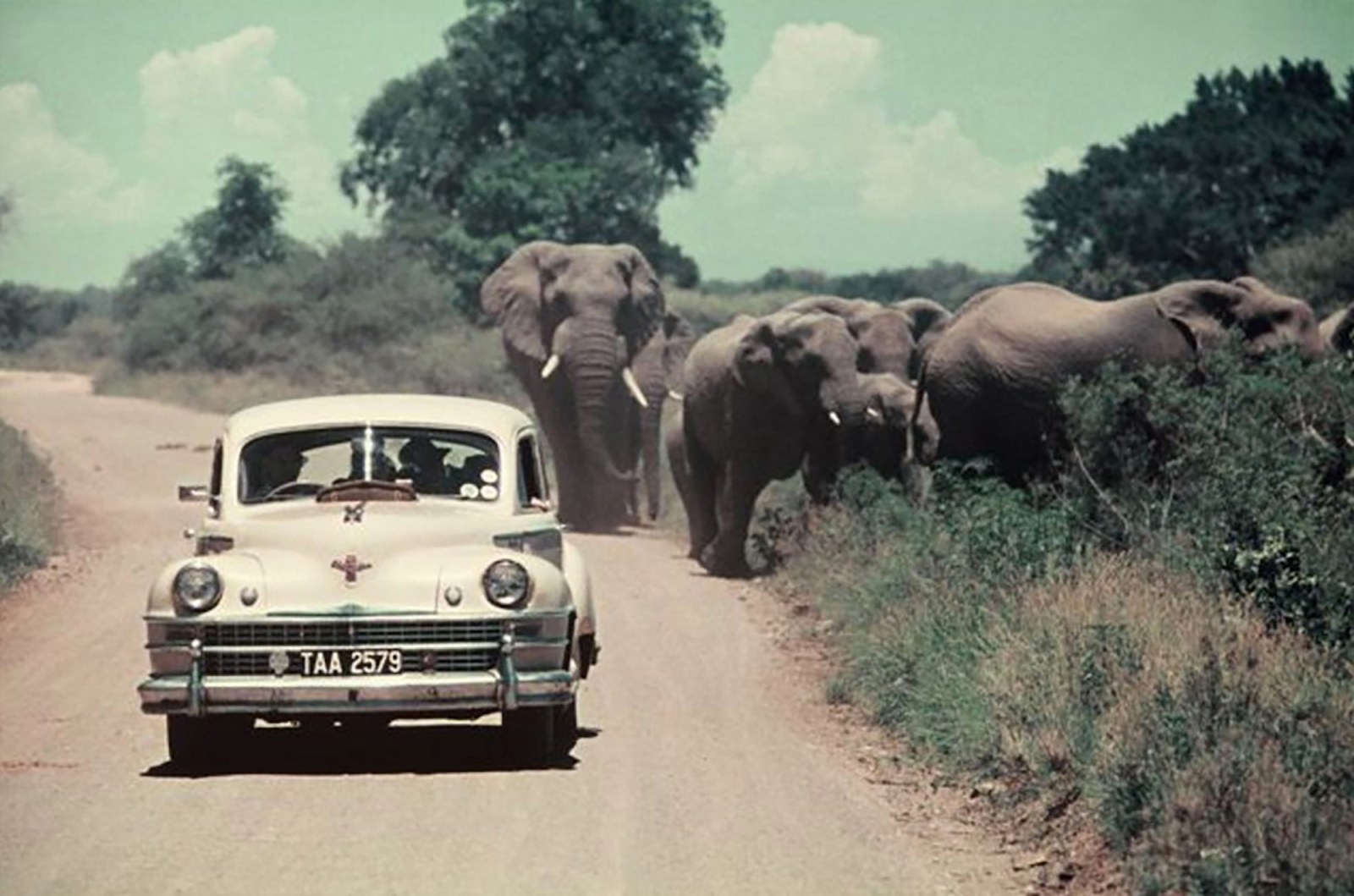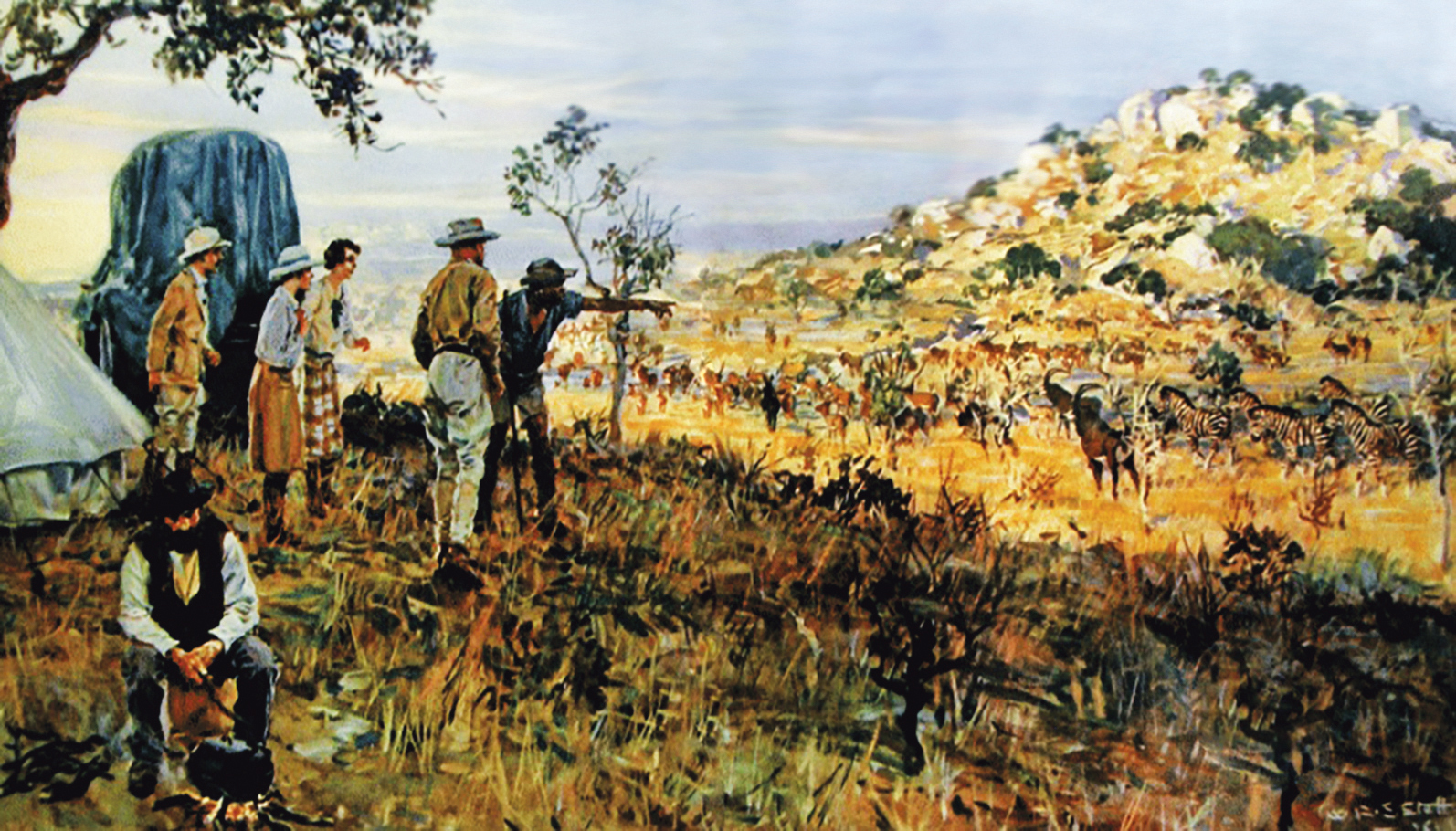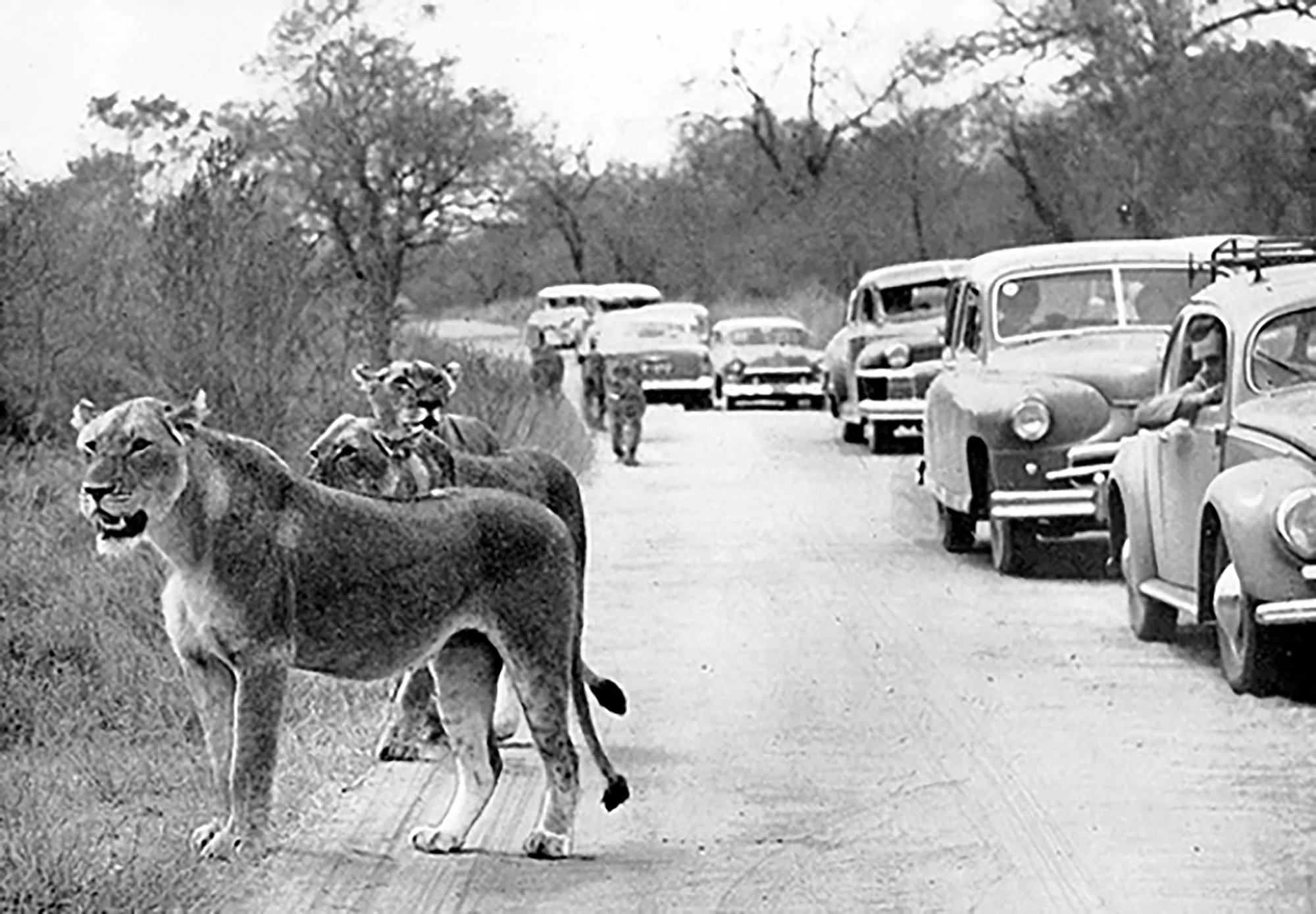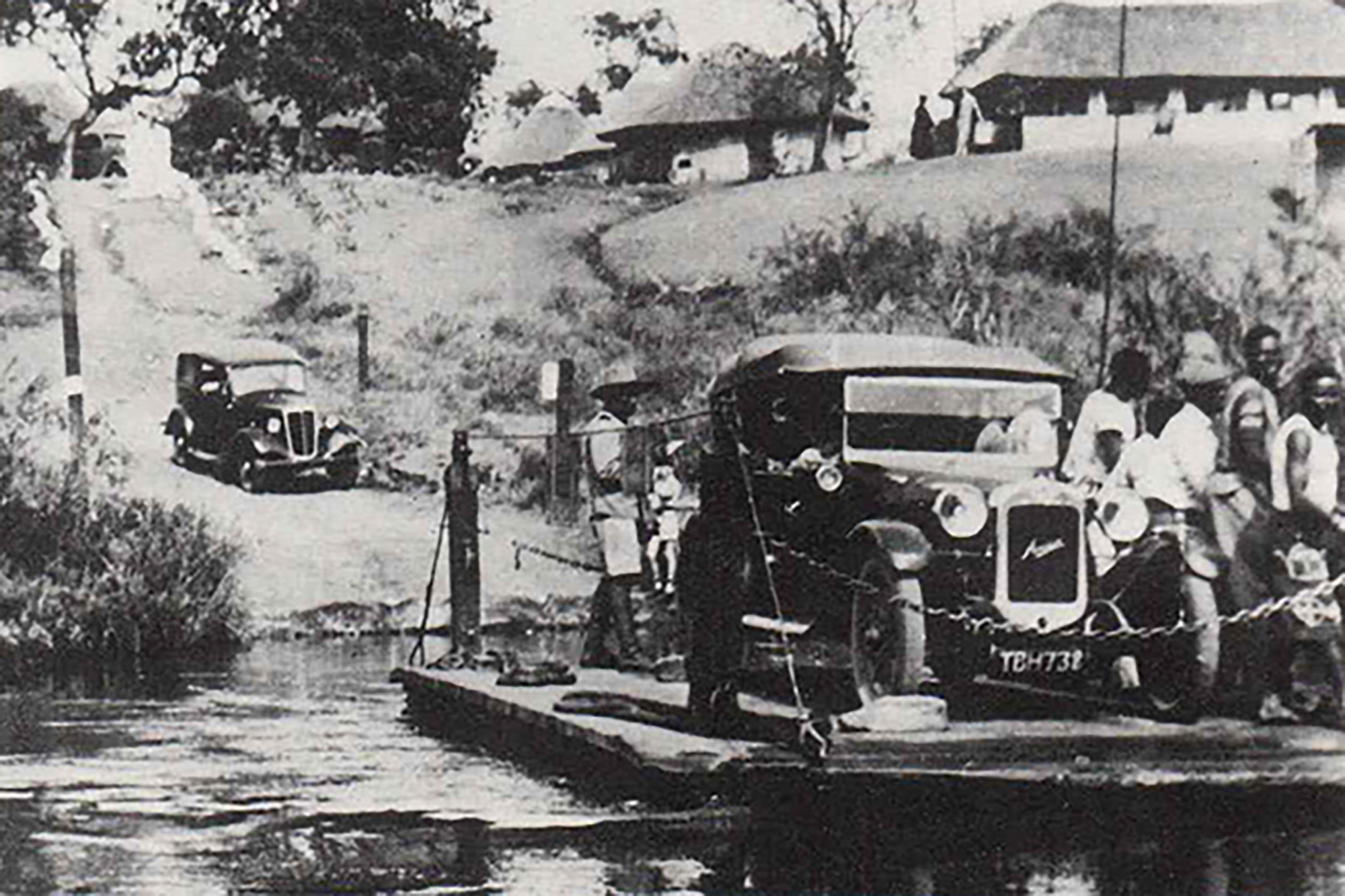The Kruger National Park and its complex history of conservation and dispossession


KNP in perspective (Part One)
The Kruger National Park and its complex history of conservation and dispossession

By the 1950s, Kruger Park had become a global ‘must-see’ destination for tourists. Photo: SANParks Archives
By Don Pinnock
Entering the Transvaal Lowveld for the first time, a Scot named James Stevenson-Hamilton had a vision: he would build one of the finest wildlife parks in the world. But people living there didn’t fit the dream.
Humans have hunted Africa’s animals since the dawn of time, but the arrival of European guns in the 17th century changed the scale of predation. It also reduced the risks, allowing adventurers and colonisers to kill for pleasure. This would prove a disaster for the continent’s abundant wildlife.
There were some among the new arrivals — amateur naturalists and scientifically minded travellers — who worried about the problems that would follow. While their countrymen hacked, hunted and impoverished the soil with their alien flocks and food crops, they complained about the disappearance of plants, animals, reptiles and birds.
But few had the vision to see where it might end.
The Swedish botanist Anders Sparrman did. Faced with the almost hysterical slaughter of ‘vermin’ around the Cape, he pleaded for an understanding of the balance of nature.
Predators, he wrote in 1772, “serve, in conjunction with mankind, to keep in a just equilibrium the increase of the animal kingdom, so that it may not exceed the supplies afforded it by the vegetable part of creation [and] lay it waste.”
The idea of a balance of nature was taken up some years later by the English naturalist William Burchell who travelled in South Africa from 1810.
“Nothing more bespeaks a littleness of mind and a narrowness of ideas,” he wrote, “than the admiring of a production of Nature merely for its magnitude, or the despising of one merely for its minuteness. Nothing is superfluous. Each has its peculiar part to perform, conducive to the well-being of all.”
Early travellers to the Lowveld where Kruger Park now lies were amazed at the richness of game. Image: SANParks Archives
The early views of men such as Sparrman and Burchell were, however, isolated shouts in the dusty avalanche of colonial expansion. Hunting and game protection laws passed to curb the slaughter of wildlife, first in the Cape, then in the Transvaal and Natal, were simply ignored.
The great herds evaporated in gunsmoke and any predators that competed were declared vermin and shot on sight. Lions took a liking to horses, caracals and jackals to sheep. Lions were too conspicuous to survive for long on the open plains and by the mid 19th century they’d disappeared from the Cape, as had Cape hunting dogs. Jackals, leopards and caracals proved far wilier, so war was declared and a price put on their heads.
In the Transvaal, they fared little better. By the end of the 19th century, sport and subsistence hunting were in full swing. Landowners refused to accept self-discipline in wildlife exploitation and any measures of enforcement were simply ignored. At the end of the 1890s rinderpest reduced still further what was left of the great herds.
This alarmed hunters running out of game. In 1898 the Volksraad — prodded into concern by members from the Lowveld and aware that the area was a malarial death trap for humans and not good for farming — proclaimed a hunting reserve in the Sabi area.
As Sabi and then Kruger were considered preserves for huntable game, lions were seen as competitors and shot on sight. Photo: SANParks Archives
The idea was to preserve game animals by curbing poaching — and shooting all predators. The proclamation, however, was acted on only in 1898 when funds were allocated for the employment of a warden.
Then the Anglo Boer War intervened. In 1902, amid post-war turbulence and an over-abundance of lawless guns, a Scot named Colonel James Stevenson-Hamilton was appointed to the post.
In his book, South African Eden, he records his moment of arrival: “It is the afternoon of July 25, 1902. On the edge of the last escarpment of the Drakensberg, overlooking the huddled welter of bush-clad ravines and rocky terraces which compose the foothills, my little caravan has come to a halt that I may for a while absorb the wonderful panorama of mountain and forest which has disclosed itself.
“Francolins are calling all around, and from a nearby donga comes the sudden clatter of a guinea fowl. Bush babblers are chatting among the trees.… It is the voice of Africa, and with it comes a sense of boundless peace and contentment.”
Photo: SANParks Archives
Heir to large estates near Glasgow, educated at Rugby and Sandhurst, Stevenson-Hamilton was a man sure of his abilities and as tough as they come. He was, furthermore, intelligent, unmarried, administratively efficient and loved the wilderness. He also had two Celtic qualities that were to serve the future Kruger National Park well: gritty tenacity and charm.
His first battle was against hunters. “There were no hunting ethics whatever,” he was to observe. “Their main consideration was the largest number [of animals] shot in the shortest time.” His parallel action was to be equally controversial: shooting all predators in order to ‘bring up’ the antelope herds — action he was later to regret — and the removal of indigenous human inhabitants from the new reserve.
Inevitably, Stevenson-Hamilton soon looked to the vast, empty areas to the north of the little Sabi reserve and began to dream: a park from Komatipoort to the Limpopo River — was it possible? Taking time off from the bush, he made the rounds of all the land-owning companies with property between the Letaba and Pafuri rivers and extracted agreements to hand over control of their areas for five years, adding 10,000 square kilometres to the reserve. This northern section became the Shingwedsi Game Reserve and was eventually incorporated into the Kruger Park.
With the inclusions came exclusions. In his book Safari Nation, Jacob Dlamini notes that “thousands of black African people were forcibly removed from the lands that were designated for the park and suffered enduring harms from this displacement, from mistreatment by park officials and from wildlife attacks.”
Lions never failed to produce traffic jams of awed tourists. Photo: SANParks Archives
At the time, Stevenson-Hamilton became Sabi warden, there were between 2,000 and 3,000 local people living within its borders. There was also a military regiment with white and black soldiers.
Within a year he had disarmed and expelled the African families and driven out the regiment. That earned him the nickname Skukuza, which means ‘the destroyer.’ That history has become part of today’s community land claims.
A madman in the wild
It’s difficult today to imagine the incomprehension with which Stevenson-Hamilton’s attitude to wildlife was regarded among all sections of the population. While in Pretoria, someone exclaimed that they envied him for the wonderful shooting he must be having down in Sabi. When he replied that neither he nor his staff ever shot an animal, the man stared at him, speechless, for a moment, then blurted out, “Why? Can’t you hit them?”
One of his African attendants once remarked to somebody: “Never have I travelled with such a white man; when he saw a zebra standing so close that I could hit it with a stone, he only looked at it. Truly, he is quite mad!”
Painfully slowly, Stevenson-Hamilton’s iron control of the reserve together with his non-hunting approach bore fruit. He argued for and obtained control over all policemen and border officials in the park area, in this way adding to his anti-poaching force. When he caught several white policemen from Komatipoort poaching, he refused to let it pass and prosecuted them, creating an outcry in the district but making a powerful point about wildlife protection.
For a while, Stevenson-Hamilton was to be vilified by many Lowvelders who objected to this ‘foreigner’ throwing his weight around. Local papers bristled with anonymous letters about ‘pampered officials’ and claimed the park was merely a government breeding ground for lions, crocodiles and wild dogs. There were calls for him to be fired. His response was characteristic. “I began to develop,” he wrote, “a certain hitherto unsuspected strain of obstinacy.”
The fracas got him thinking, though. Why waste all this time and money simply to build up a future hunting reserve? Why not, instead, turn it into a national park held in trust for perpetuity? Was there possibly a future in that?
Local communities provided most of the rangers employed by Stevenson-Hamilton. Photo: SANParks Archives
The seed had been sown. Stevenson-Hamilton began to agitate, something he proved remarkably good at. “I would talk at great length about national parks — when I could get anyone to listen to me.”
When a railway line was routed through the park in 1912, he got trains to stop for a bush lunch so passengers could admire the wildlife. It proved a runaway success with tourists. In 1916 a commission was appointed to assess the future of the reserves and its members were taken on a tour by Stevenson-Hamilton. They were bowled over by the beauty of the Lowveld. “The Spirit of the Wild is quick to assert her supremacy,” he would write, “every member of the commission soon became a confirmed game protectionist.”
In its report, the commission insisted that the park should be more than a preservation of fauna — “it should become a wilderness for all to enjoy.” The seed had taken root, though ‘all’ did not include everyone.
As the legislative wheels began to turn, slowly as ever, Stevenson-Hamilton and his friend, the South African Railways publicity officer Stratford Caldecott, hit on an idea that was pure marketing. As an act of conciliation by the British administration, why not call it the Kruger National Park? And that, in 1926 when the National Parks Act was passed, is what it became.
This was a politically delicate manoeuvre at a time when Afrikaner nationalism was growing and British colonial sentiments retreating. The national park — together with naming it after Paul Kruger, an Afrikaner hero — was an exercise to bring together the two white communities in South Africa in a common project. In that exercise, the views of communities that had lived there for many generations were disregarded.
The name was purely political. The Volksraad minutes clearly show that President Kruger had never given much support to wildlife protection and, Stevenson-Hamilton wrote, never in his life thought of wild animals except as biltong. “I wonder what he would say could he see himself depicted as the Saviour of the South African Game?”
Cinderella of the bushveld
In the years which followed, as almost exclusively white people streamed into the new park, Stevenson-Hamilton watched in wonder as what he called his Cinderella became a princess and part of the country’s national identity.
VIsitors watch for hippos and crocs as they cross the river by punt. Photo: SANParks Archives
In 1927, the year it was opened to the public, only 10 carloads braved it, but by 1935 some 26,000 people had made the pilgrimage. Today the number, pre-Covid, has been around a million a year. Stevenson-Hamilton retired in 1946 after nearly half a century as park warden and settled down to pen his memoirs.
“Nature, left entirely alone,” he would write, “manages her own affairs. Predatory creatures, great and small, and whether of the earth, air or water, have their full place in nature, just as much as the animals on which they are accustomed to prey, and are entitled to equal respect.” Understand this, he said, and nature will transform you. “Ignore it and she will return armed with a pitchfork.”
Interestingly, the park did not follow the standard apartheid dictum of excluding blacks, though they were included by degrees. As Dlamini writes, initially maids were permitted to accompany families and the park’s staff were mainly African. The Bantustan ‘homeland’ system widened the gap. In order for the ‘independence’ of these puppet states to be accepted, their citizens had to be treated as international visitors. And they came.
Dlamini suggests this was one of the reasons the government under Mandela supported Kruger Park as part of its vision of democratic and inclusive conservation. Today nearly half of the park’s visitors are not European. But the legacy of exclusion has consequences. DM/OBP
Language of the news reported
Related content:
Copyright © Source (mentioned above). All rights reserved. The Land Portal distributes materials without the copyright owner’s permission based on the “fair use” doctrine of copyright, meaning that we post news articles for non-commercial, informative purposes. If you are the owner of the article or report and would like it to be removed, please contact us at hello@landportal.info and we will remove the posting immediately.
Various news items related to land governance are posted on the Land Portal every day by the Land Portal users, from various sources, such as news organizations and other institutions and individuals, representing a diversity of positions on every topic. The copyright lies with the source of the article; the Land Portal Foundation does not have the legal right to edit or correct the article, nor does the Foundation endorse its content. To make corrections or ask for permission to republish or other authorized use of this material, please contact the copyright holder.






